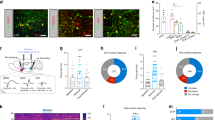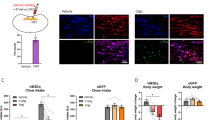Abstract
Licking behavior is important for water intake. The deep mesencephalic nucleus (DpMe) has been implicated in instinctive behaviors. However, whether the DpMe is involved in licking behavior and the precise neural circuit behind this behavior remains unknown. Here, we found that the activity of the DpMe decreased during water intake. Inhibition of vesicular glutamate transporter 2-positive (VGLUT2+) neurons in the DpMe resulted in increased water intake. Somatostatin-expressing (SST+), but not protein kinase C-δ-expressing (PKC-δ+), GABAergic neurons in the central amygdala (CeA) preferentially innervated DpMe VGLUT2+ neurons. The SST+ neurons in the CeA projecting to the DpMe were activated at the onset of licking behavior. Activation of these CeA SST+ GABAergic neurons, but not PKC-δ+ GABAergic neurons, projecting to the DpMe was sufficient to induce licking behavior and promote water intake. These findings redefine the roles of the DpMe and reveal a novel CeASST–DpMeVGLUT2 circuit that regulates licking behavior and promotes water intake.






Similar content being viewed by others
References
Travers JB, Dinardo LA, Karimnamazi H. Motor and premotor mechanisms of Licking. Neurosci Biobehav Rev 1997, 21: 631–647.
Andersson B, Leksell LG, Lishajko F. Perturbations in fluid balance induced by medially placed forebrain lesions. Brain Res 1975, 99: 261–275.
Thrasher TN, Keil LC, Ramsay DJ. Lesions of the organum vasculosum of the Lamina terminalis (OVLT) attenuate osmotically-induced drinking and vasopressin secretion in the dog. Endocrinology 1982, 110: 1837–1839.
Zimmerman CA, Leib DE, Knight ZA. Neural circuits underlying thirst and fluid homeostasis. Nat Rev Neurosci 2017, 18: 459–469.
Gong R, Xu S, Hermundstad A, Yu Y, Sternson SM. Hindbrain double-negative feedback mediates palatability-guided food and water consumption. Cell 2020, 182: 1589-1605.e22.
Kim DY, Heo G, Kim M, Kim H, Jin JA, Kim HK. A neural circuit mechanism for mechanosensory feedback control of ingestion. Nature 2020, 580: 376–380.
Rossi MA, Li HE, Lu D, Kim IH, Bartholomew RA, Gaidis E, et al. A GABAergic nigrotectal pathway for coordination of drinking behavior. Nat Neurosci 2016, 19: 742–748.
Liang CL, Quang Nguyen T, Marks GA. Inhibitory and excitatory amino acid neurotransmitters are utilized by the projection from the dorsal deep mesencephalic nucleus to the sublaterodorsal nucleus REM sleep induction zone. Brain Res 2014, 1567: 1–12.
Chen ZK, Yuan XS, Dong H, Wu YF, Chen GH, He M, et al. Whole-brain neural connectivity to lateral pontine tegmentum GABAergic neurons in mice. Front Neurosci 2019, 13: 375.
Gorbachevskaia AI. Interconnections of the pallidum, pedunculopontine nucleus, zona incerta, and deep mesencephalic nucleus—the structures of the basal Ganglia Morpho-functional system. Morfologiia 2011, 139: 19–24.
Zhao Z, Yang Y, Walker DL, Davis M. Effects of substance P in the amygdala, ventromedial hypothalamus, and periaqueductal gray on fear-potentiated startle. Neuropsychopharmacology 2009, 34: 331–340.
Mukerjee S, Lazartigues E. Next-generation tools to study autonomic regulation in vivo. Neurosci Bull 2019, 35: 113–123.
Andrade-Franzé GMF, Andrade CAF, Gasparini S, de Luca Jr LA, de Paula Jr PM, Colombari DSA Jr, et al. Importance of the central nucleus of the amygdala on sodium intake caused by deactivation of lateral parabrachial nucleus. Brain Res 2015, 1625: 238–245.
Andrade-Franzé GM, Gasparini S, De Luca LA, De Paula PM, De Paula PM, Colombari DS, et al. Lateral parabrachial nucleus and opioid mechanisms of the central nucleus of the amygdala in the control of sodium intake. Behav Brain Res 2017, 316: 11–17.
Menani JV, De Luca Jr LA, Johnson AK. Role of the lateral parabrachial nucleus in the control of sodium appetite. Am J Physiol Regul Integr Comp Physiol 2014, 306: R201-210.
Pereira-Derderian DT, Vendramini RC, Menani JV, De Luca LA. Water deprivation-induced sodium appetite and differential expression of encephalic c-Fos immunoreactivity in the spontaneously hypertensive rat. Am J Physiol Regul Integr Comp Physiol 2010, 298: R1298–R1309.
Ehrlich I, Humeau Y, Grenier F, Ciocchi S, Herry C, Lüthi A. Amygdala inhibitory circuits and the control of fear memory. Neuron 2009, 62: 757–771.
McCullough KM, Morrison FG, Hartmann J, Carlezon WA, Jr., Ressler KJ. Quantified coexpression analysis of central amygdala subpopulations. eNeuro 2018, 5.
Kim J, Zhang XY, Muralidhar S, LeBlanc SA, Tonegawa S. Basolateral to central amygdala neural circuits for appetitive behaviors. Neuron 2017, 93: 1464-1479.e5.
Fu JY, Yu XD, Zhu Y, Xie SZ, Tang MY, Yu B, et al. Whole-brain map of long-range monosynaptic inputs to different cell types in the amygdala of the mouse. Neurosci Bull 2020, 36: 1381–1394.
Lein ES, Hawrylycz MJ, Ao N, Ayres M, Bensinger A, Bernard A, et al. Genome-wide atlas of gene expression in the adult mouse brain. Nature 2007, 445: 168–176.
Zhang H, Li K, Chen HS, Gao SQ, Xia ZX, Zhang JT, et al. Dorsal raphe projection inhibits the excitatory inputs on lateral habenula and alleviates depressive behaviors in rats. Brain Struct Funct 2018, 223: 2243–2258.
Tervo DG, Hwang BY, Viswanathan S, Gaj T, Lavzin M, Ritola KD, et al. A designer AAV variant permits efficient retrograde access to projection neurons. Neuron 2016, 92: 372–382.
Augustine V, Gokce SK, Lee S, Wang B, Davidson TJ, Reimann F, et al. Hierarchical neural architecture underlying thirst regulation. Nature 2018, 555: 204–209.
Dalmasso C, Antunes-Rodrigues J, Vivas L, de Luca Jr LA. Mapping brain Fos immunoreactivity in response to water deprivation and partial rehydration: Influence of sodium intake. Physiol Behav 2015, 151: 494–501.
Augustine V, Gokce SK, Oka Y. Peripheral and central nutrient sensing underlying appetite regulation. Trends Neurosci 2018, 41: 526–539.
González-Hernández T, Barroso-Chinea P, Pérez de la Cruz MA, Valera P, Dopico JG, Rodríguez M. Response of GABAergic cells in the deep mesencephalic nucleus to dopaminergic cell degeneration: An electrophysiological and in situ hybridization study. Neuroscience 2002, 113: 311–321.
Acknowledgements
We thank Dr. Shumin Duan and Dr. Yanqin Yu for generously providing the VGLUT2-Cre mice. We are grateful to Research Assistant Shuangshuang Liu from the Core Facilities of Zhejiang University School of Medicine, as well as Dr. Sanhua Fang and Research Assistants Daohui Zhang and Li Liu from the Core Facilities of Zhejiang University Institute of Neuroscience. This work was supported by the Key-Area Research and Development Program of Guangdong Province (2019B030335001 and 2018B030334001), the Natural Science Foundation of China (31871070 and 82090031), the Key R&D Program of Zhejiang Province (2020C03009), Fundamental Research Funds for the Central Universities 2021FZZX001-37, the Non-Profit Central Research Institute Fund of the Chinese Academy of Medical Sciences (2019PT310023), and the CAMS Innovation Fund for Medical Sciences (2019-I2M-5-057).
Author information
Authors and Affiliations
Corresponding author
Ethics declarations
Conflict of interest
The authors declare no conflict of interest.
Supplementary Information
Below is the link to the electronic supplementary material.
Rights and permissions
About this article
Cite this article
Zheng, D., Fu, JY., Tang, MY. et al. A Deep Mesencephalic Nucleus Circuit Regulates Licking Behavior. Neurosci. Bull. 38, 565–575 (2022). https://doi.org/10.1007/s12264-021-00817-2
Received:
Accepted:
Published:
Issue Date:
DOI: https://doi.org/10.1007/s12264-021-00817-2




